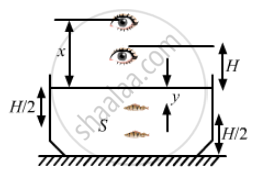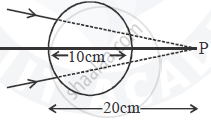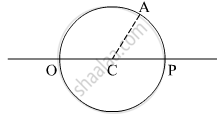Advertisements
Advertisements
प्रश्न
Consider the situation in figure. The bottom of the pot is a reflecting plane mirror, S is a small fish and T is a human eye. Refractive index of water is μ. (a) At what distance(s) from itself will the fish see the image(s) of the eye? (b) At what distance(s) from itself will the eye see the image(s) of the fish.

उत्तर
Given,
Refractive index of water = μ.
Height of the pot = H
Let us take x as the distance of the image of the eye formed above the surface of the water as seen by the fish.
We can infer from from the diagram,
The distance of the direct image
Similarly, image through mirror =
b) We know that:
Where, y is the distance of the image of the fish below the surface as seen by the eye.
Direct image =
Again another image of fish will be formed H/2 below the mirror.
Real depth for that image of fish becomes H + H/2 = 3H/2
So, apparent depth from the surface of water = 3H/2μ
So, distance of the image from the eye
APPEARS IN
संबंधित प्रश्न
Light of wavelength 5000 Å propagating in air gets partly reflected from the surface of water. How will the wavelengths and frequencies of the reflected and refracted light be affected?
A small pin fixed on a table top is viewed from above from a distance of 50 cm. By what distance would the pin appear to be raised if it is viewed from the same point through a 15 cm thick glass slab held parallel to the table? Refractive index of glass = 1.5. Does the answer depend on the location of the slab?
Does the apparent depth of a tank of water change if viewed obliquely? If so, does the apparent depth increase or decrease?
A converging beam of light travelling in air converges at a point P as shown in the figure. When a glass sphere of refractive index 1 . 5 is introduced in between the path of the beam, calculate the new position of the image. Also draw the ray diagram for the image formed.


Choose the correct option.
There are different fish, monkeys, and water of the habitable planet of the star Proxima b. A fish swimming underwater feels that there is a monkey at 2.5 m on the top of a tree. The same monkey feels that the fish is 1.6 m below the water surface. Interestingly, height of the tree and the depth at which the fish is swimming are exactly same. Refractive index of that water must be
A ray of light travelling in a transparent medium of refractive index n falls, on a surface separating the medium from air at an angle of incidents of 45°. The ray can undergo total internal reflection for the following n.
What is angle of deviation due to refraction?
What is a principle of reversibility?
What is relative refractive index?
Obtain the equation for critical angle.
How does an endoscope work?
Obtain the equation for lateral displacement of light passing through a glass slab.
A ray of light travels from air to water to glass and aga in from glass to air. Refractive index of water with respect to air is 'x' glass with respect to water is 'y' and air with respect to glass is 'z'. which one of the following is correct?
The critical angle for a ray of light from glass to air is 'θ' and refractive index of glass with respect to air is 'n'. If a ray of light is incident from air to glass at an angle 'θ', then corresponding angle of refraction is ______.
The critical angle is maximum when light travels from ______.
Light travels in two media A and B with speeds 1.8 × 108 ms−1 and 2.4 × 108 ms−1 respectively. Then the critical angle between them is:
There are certain material developed in laboratories which have a negative refractive index (Figure). A ray incident from air (medium 1) into such a medium (medium 2) shall follow a path given by.
A convex lens made of material of refractive index 1.5 and having a focal length of 10 cm is immersed in a liquid of refractive index 3.0. The lens will behave as ______.
